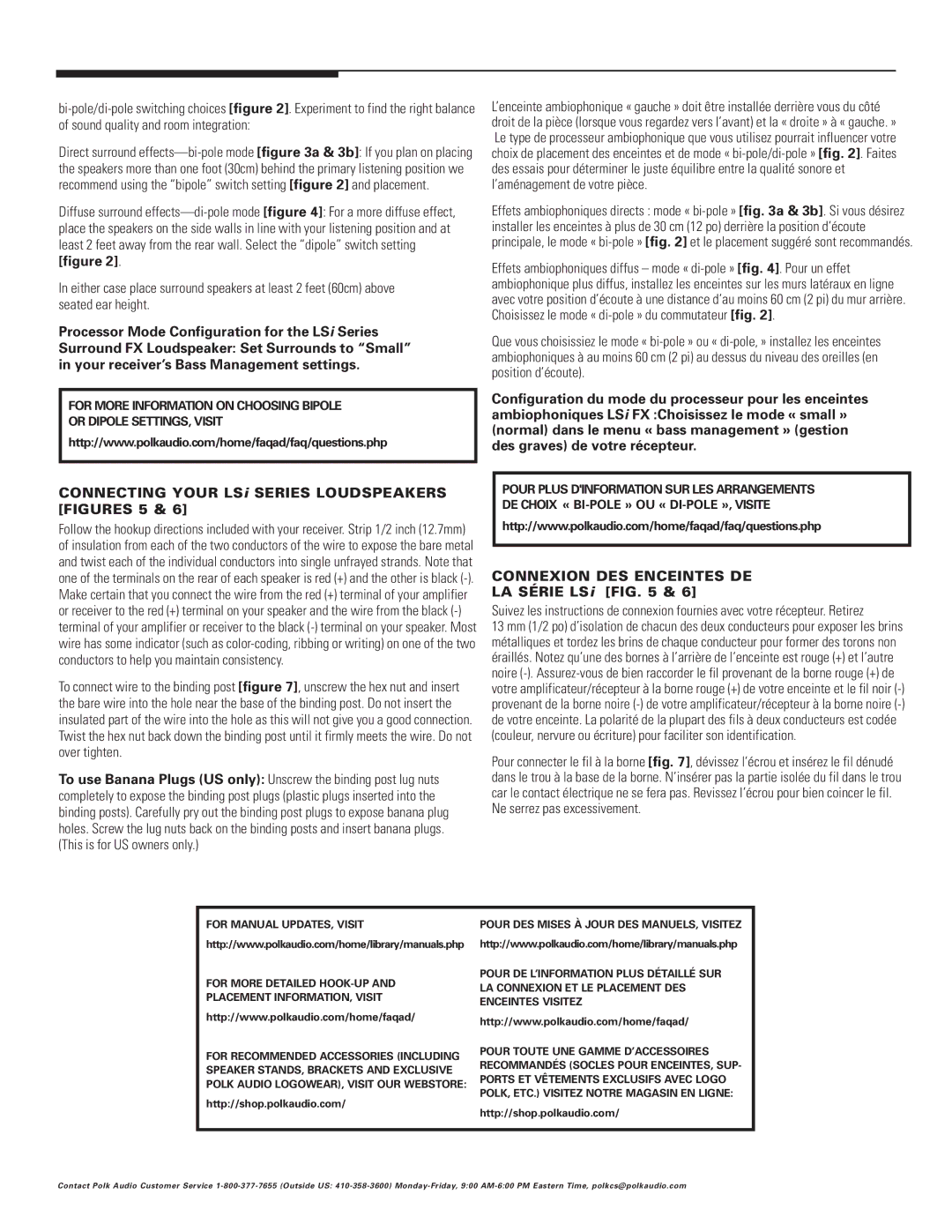
Direct surround
Diffuse surround
In either case place surround speakers at least 2 feet (60cm) above seated ear height.
Processor Mode Configuration for the LSi Series Surround FX Loudspeaker: Set Surrounds to “Small” in your receiver’s Bass Management settings.
FOR MORE INFORMATION ON CHOOSING BIPOLE
OR DIPOLE SETTINGS, VISIT
http://www.polkaudio.com/home/faqad/faq/questions.php
CONNECTING YOUR LSi SERIES LOUDSPEAKERS [FIGURES 5 & 6]
Follow the hookup directions included with your receiver. Strip 1/2 inch (12.7mm) of insulation from each of the two conductors of the wire to expose the bare metal and twist each of the individual conductors into single unfrayed strands. Note that one of the terminals on the rear of each speaker is red (+) and the other is black
To connect wire to the binding post [figure 7], unscrew the hex nut and insert the bare wire into the hole near the base of the binding post. Do not insert the insulated part of the wire into the hole as this will not give you a good connection. Twist the hex nut back down the binding post until it firmly meets the wire. Do not over tighten.
To use Banana Plugs (US only): Unscrew the binding post lug nuts completely to expose the binding post plugs (plastic plugs inserted into the binding posts). Carefully pry out the binding post plugs to expose banana plug holes. Screw the lug nuts back on the binding posts and insert banana plugs. (This is for US owners only.)
L’enceinte ambiophonique « gauche » doit être installée derrière vous du côté droit de la pièce (lorsque vous regardez vers l’avant) et la « droite » à « gauche. » Le type de processeur ambiophonique que vous utilisez pourrait influencer votre choix de placement des enceintes et de mode «
Effets ambiophoniques directs : mode «
Effets ambiophoniques diffus – mode «
Que vous choisissiez le mode «
Configuration du mode du processeur pour les enceintes ambiophoniques LSi FX :Choisissez le mode « small » (normal) dans le menu « bass management » (gestion des graves) de votre récepteur.
POUR PLUS D'INFORMATION SUR LES ARRANGEMENTS
DE CHOIX «
http://www.polkaudio.com/home/faqad/faq/questions.php
CONNEXION DES ENCEINTES DE
LA SÉRIE LSi [FIG. 5 & 6]
Suivez les instructions de connexion fournies avec votre récepteur. Retirez
13 mm (1/2 po) d’isolation de chacun des deux conducteurs pour exposer les brins métalliques et tordez les brins de chaque conducteur pour former des torons non éraillés. Notez qu’une des bornes à l’arrière de l’enceinte est rouge (+) et l’autre noire
Pour connecter le fil à la borne [fig. 7], dévissez l’écrou et insérez le fil dénudé dans le trou à la base de la borne. N’insérer pas la partie isolée du fil dans le trou car le contact électrique ne se fera pas. Revissez l’écrou pour bien coincer le fil. Ne serrez pas excessivement.
FOR MANUAL UPDATES, VISIT | POUR DES MISES À JOUR DES MANUELS, VISITEZ | |
http://www.polkaudio.com/home/library/manuals.php | http://www.polkaudio.com/home/library/manuals.php | |
FOR MORE DETAILED | POUR DE L’INFORMATION PLUS DÉTAILLÉ SUR | |
LA CONNEXION ET LE PLACEMENT DES | ||
PLACEMENT INFORMATION, VISIT | ||
ENCEINTES VISITEZ | ||
| ||
http://www.polkaudio.com/home/faqad/ | http://www.polkaudio.com/home/faqad/ | |
| ||
FOR RECOMMENDED ACCESSORIES (INCLUDING | POUR TOUTE UNE GAMME D’ACCESSOIRES | |
RECOMMANDÉS (SOCLES POUR ENCEINTES, SUP- | ||
SPEAKER STANDS, BRACKETS AND EXCLUSIVE | ||
PORTS ET VÊTEMENTS EXCLUSIFS AVEC LOGO | ||
POLK AUDIO LOGOWEAR), VISIT OUR WEBSTORE: | ||
POLK, ETC.) VISITEZ NOTRE MAGASIN EN LIGNE: | ||
http://shop.polkaudio.com/ | ||
http://shop.polkaudio.com/ | ||
| ||
|
|
Contact Polk Audio Customer Service
